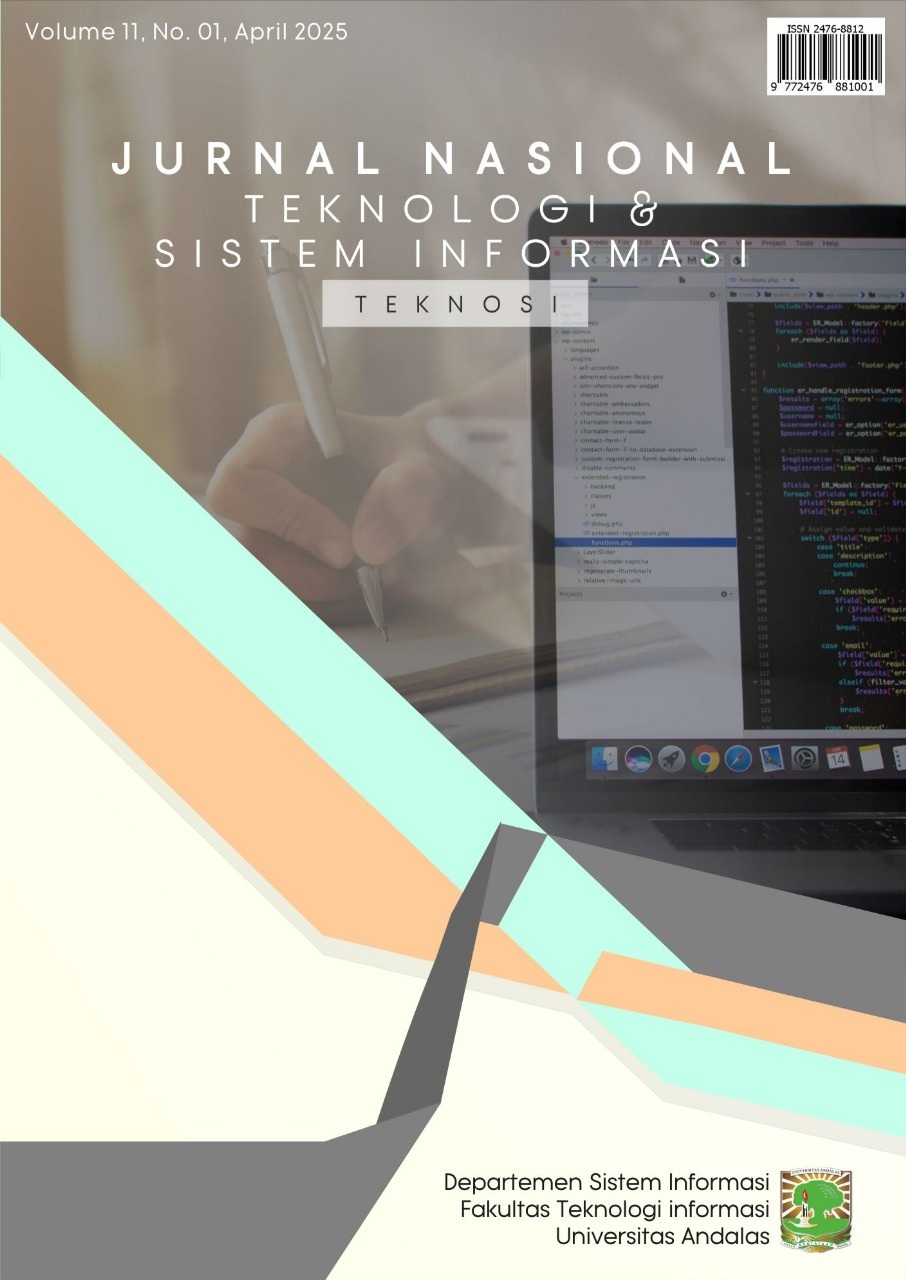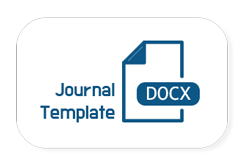Optimasi LDA untuk Analisis Keluhan Nasabah Perbankan dengan Grid Search
Grid Search Parameter Tuning
DOI:
https://doi.org/10.25077/TEKNOSI.v11i2.2025.98-106Kata Kunci:
Grid Search Parameter Tuning, Kepuasan nasabah, Keluhan nasabah perbankan, Pemodelan topik., Latent Dirichlet AllocationAbstrak
Penelitian ini bertujuan untuk menganalisis topik pada data keluhan nasabah perbankan menggunakan metode Latent Dirichlet Allocation (LDA) yang disempurnakan dengan penyetelan parameter menggunakan Grid Search. Dataset berasal dari situs ConsumerFinance.gov dengan total 6,3 juta entri keluhan dari tahun 2011 hingga 2024, dan 50% data digunakan untuk menjaga representasi dan menyederhanakan analisis. Dalam analisis ini, metode LDA digunakan untuk mengidentifikasi topik-topik tersembunyi, sementara Grid Search meningkatkan koherensi model. Hasil penelitian menunjukkan bahwa keluhan nasabah dapat dikelompokkan ke dalam 10 topik utama, seperti masalah laporan keluhan (25,67%), kesalahan pembayaran (18,10%), otorisasi data (12,20%), dan kebijakan kredit (10,77%). Optimasi parameter berhasil meningkatkan skor koherensi model dari 0,49 menjadi 0,56, mencerminkan peningkatan kualitas clustering topik. Perbandingan metode LDA standar dan LDA dengan Grid Search menunjukkan bahwa metode optimasi memberikan nilai rata-rata koherensi lebih tinggi (0,52 vs. 0,42). Dengan temuan ini, model LDA yang telah di optimasi dapat digunakan oleh industri perbankan untuk memahami dan menangani keluhan pelanggan dengan lebih efektif.Referensi
. K. Bastani, H. Namavari, and J. Shaffer, “Latent Dirichlet Allocation (LDA),” J. Machine Learn. Res., vol. 12, no. 3, pp. 34–56, Mar. 2020, doi: 10.1016/j.jmlr.2020.03.005.
. I. Ayres, J. Lingwall, and S. Steinway, “Skeletons in the database: An early analysis of the CFPB’s consumer complaints,” Fordham J. Corp. Financial Law, vol. 19, pp. 343–386, 2013.
. A. K. Littwin, “Examination as a method of consumer protection,” Temple Law Rev., vol. 87, pp. 807–874, 2015.
. K. Berezina, A. Bilgihan, C. Cobanoglu, and F. Okumus, “Understanding satisfied and dissatisfied hotel consumers: Text mining of online hotel reviews,” J. Hosp. Market. Manage., vol. 25, no. 1, pp. 1–24, 2016, doi: 10.1080/19368623.2015.983631.
. Consumer Financial Protection Bureau, “Dataset customer complaints,” 2025. [Online]. Available: https://www.consumerfinance.gov/complaint/
. R. Rehurek and P. Sojka, “Software framework for topic modelling with large corpora,” in Proc. LREC 2010 Workshop on New Challenges for NLP Frameworks, 2010, pp. 45–50.
. S. Bird, E. Klein, and E. Loper, Natural Language Processing with Python, 1st ed. Sebastopol, CA, USA: O’Reilly Media, 2009.
. M. Honnibal and I. Montani, “spaCy 2: Natural language understanding with bloom embeddings, convolutional neural networks, and incremental parsing,” in Proc. 2017 Conf. Natural Language Processing, 2017. [Online]. Available: https://doi.org/10.18653/v1/D17-1202.
. F. Pedregosa et al., “Scikit-learn: Machine learning in Python,” J. Machine Learn. Res., vol. 12, pp. 2825–2830, 2011.
. C. Sievert and K. Shirley, “LDAvis: A method for visualizing and interpreting topics,” in Proc. Workshop on Interactive Language Learning, Visualization, and Interfaces, 2014, pp. 63–70, doi: 10.3115/v1/W14-3110.
. T. E. Oliphant, A Guide to NumPy, Trelgol Publishing, 2006.
. Tqdm Development Team, “tqdm: A fast, extensible progress bar,” 2019. [Online]. Available: https://github.com/tqdm/tqdm.
. K. Kartikadyota, I. Dwijayanti, A. R. Lahtiani, and M. Habibi, “Analisis tren topik dalam ulasan negatif aplikasi M-Banking menggunakan Latent Dirichlet Allocation,” J. Fasilkom, vol. 14, no. 3, pp. 549–555, 2024.
. J. Bergstra and Y. Bengio, “Random Search for Hyper-Parameter Optimization,” J. Machine Learn. Res., vol. 13, pp. 281–305, 2012.
. D. M. Blei, A. Y. Ng, and M. I. Jordan, “Latent Dirichlet Allocation,” J. Machine Learn. Res., vol. 3, pp. 993–1022, 2003. [Online]. Available: https://www.jmlr.org/papers/volume3/blei03a/blei03a.pdf.
. D. Mimno, H. Wallach, E. Talley, M. Leenders, and A. McCallum, “Optimizing semantic coherence in topic models,” in Proc. Conf. Empirical Methods in Natural Language Processing (EMNLP), Edinburgh, UK, 2011, pp. 262–272. [Online]. Available: https://aclanthology.org/D11-1002.
. Blei, D. M., Ng, A. Y., & Jordan, M. I., “Latent Dirichlet Allocation,” J. Machine Learn. Res., vol. 3, pp. 993-1022, 2003. [Online]. Available: https://www.jmlr.org/papers/volume3/blei03a/blei03a.pdf.
. D. M. Blei, A. Y. Ng, and M. I. Jordan, "Latent Dirichlet Allocation," J. Machine Learn. Res., vol. 3, pp. 993–1022, 2003. [Online]. Available: https://jmlr.org/papers/v3/blei03a.html
. D. Mimno, H. Wallach, E. Talley, M. Leenders, and A. McCallum, “Optimizing semantic coherence in topic models,” in Proc. Conf. Empirical Methods in Natural Language Processing (EMNLP), Edinburgh, UK, 2011, pp. 262–272. [Online]. Available: https://aclanthology.org/D11-1002.NOMENKLATUR
Unduhan
Telah diserahkan
Diterima
Diterbitkan
Cara Mengutip
Terbitan
Bagian
Lisensi
Hak Cipta (c) 2025 Jurnal Nasional Teknologi dan Sistem Informasi

Artikel ini berlisensiCreative Commons Attribution-ShareAlike 4.0 International License.
Hak cipta untuk artikel ini ditransfer ke Jurnal Nasional Teknologi dan Sistem Informasi (TEKNOSI) jika dan ketika artikel diterima untuk publikasi. Yang bertanda tangan di bawah ini dengan ini mentransfer setiap dan semua hak di dalam dan ke kertas termasuk tanpa batasan semua hak cipta untuk TEKNOSI. Yang bertanda tangan di bawah ini dengan ini menyatakan dan menjamin bahwa makalah tersebut asli dan bahwa ia adalah pembuat makalah, kecuali untuk bahan yang secara jelas diidentifikasi sebagai sumber aslinya, dengan pemberitahuan izin dari pemilik hak cipta jika diperlukan. Yang bertanda tangan di bawah ini menyatakan bahwa ia memiliki kekuatan dan wewenang untuk membuat dan melaksanakan penugasan ini.
Kami menyatakan bahwa:
- Makalah ini belum diterbitkan dalam bentuk yang sama di tempat lain.
- Makalah ini tidak akan dikirimkan di tempat lain untuk publikasi sebelum penerimaan/penolakan oleh Jurnal ini
- Izin hak cipta diperoleh untuk materi yang diterbitkan di tempat lain dan yang memerlukan izin ini untuk reproduksi.
Selanjutnya, Saya/kami dengan ini mentransfer hak publikasi yang tidak terbatas dari makalah yang disebutkan di atas secara keseluruhan kepada TEKNOSI. Transfer hak cipta mencakup hak untuk mereproduksi dan mendistribusikan artikel, termasuk cetak ulang, terjemahan, reproduksi foto, mikroform, bentuk elektronik (offline, online) atau reproduksi lain yang serupa.
Penulis yang sesuai menandatangani dan menerima tanggung jawab untuk merilis materi ini atas nama setiap dan semua penulis bersama. Perjanjian ini harus ditandatangani oleh setidaknya salah satu penulis yang telah memperoleh persetujuan dari rekan penulis jika berlaku. Setelah pengajuan perjanjian ini ditandatangani oleh penulis yang sesuai, perubahan kepengarangan atau dalam urutan penulis yang tercantum tidak akan diterima.
Hak / Syarat dan Ketentuan yang dipertahankan :
- Penulis memiliki semua hak kepemilikan dalam setiap proses, prosedur, atau artikel manufaktur yang dijelaskan dalam Karya ini.
- Penulis dapat mereproduksi atau mengotorisasi orang lain untuk mereproduksi karya ini atau karya turunannya untuk penggunaan pribadi penulis atau untuk penggunaan perusahaan, dengan ketentuan bahwa sumber dan menyatakan hak cipta dimiliki TEKNOSI, salinan tidak digunakan dengan cara apa pun yang menyiratkan pengesahan TEKNOSI atas suatu produk atau layanan dari pihak mana pun, dan salinannya sendiri tidak ditawarkan untuk dijual.
- Meskipun penulis diizinkan untuk menggunakan kembali semua atau sebagian dari karya ini dalam karya lain, ini tidak termasuk mengabulkan permintaan pihak ketiga untuk mencetak ulang, menerbitkan ulang, atau jenis penggunaan ulang lainnya.














